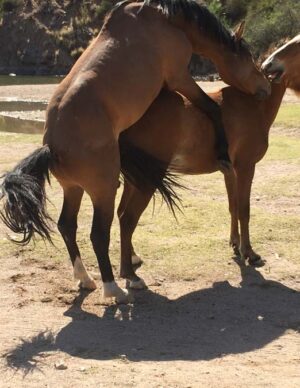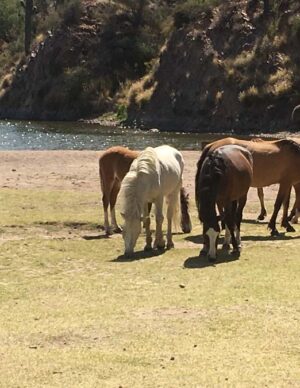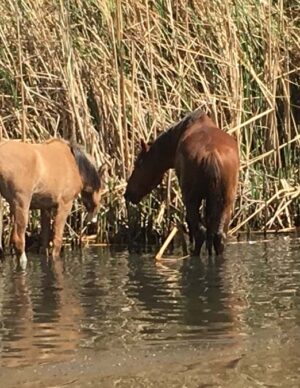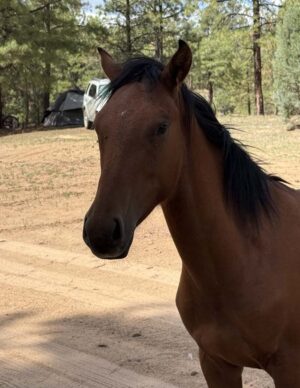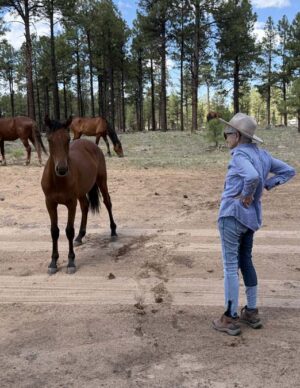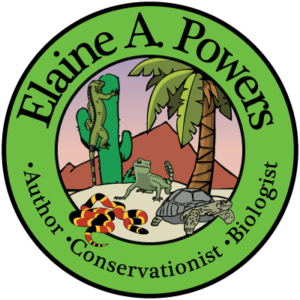Close Encounters of the Wild Kind: When Wild Horses Stop You From Leaving
Since moving to Arizona, I’ve had the thrill of interacting with many wild horses. I know they are an introduced species, but seeing properly managed, healthy herds roaming free is a true joy—especially when I encounter them on my trail rides.
Sun, Sand, and Stallions at Butcher Jones Beach
My first encounter with the Salt River herd was at Butcher Jones Beach in Tonto National Forest. These horses have learned to eat the river grass and gather along the banks—and sometimes right in the water—to feed and cool off.
The beach is also a popular spot for people, so the horses and people have to contend with each other. The horses generally go about their horsey business, but people often get too close. This can be dangerous; horses are large, powerful prey animals that will defend themselves against anything they perceive as a threat, including annoying dogs foolishly let off-leash.
During my first visit, a fierce battle erupted when an unwelcome stallion approached a mare that was in heat. The mare was willing, but the herd stallion’s lieutenants quickly intervened. A battle ensued, the suitor was driven off, and the mare was chastised—all within 50 feet of lounging humans. This kind of scenario made officials cautious, and eventually, the beach was closed to the horses.
Coon Bluff: A River of Horses
My friend, a photographer from the East Coast, visits annually, and seeing the wild horses is always a priority. After the beach was closed, a friendly local suggested a new viewing spot: Coon Bluff Recreation Area (sometimes called Raccoon Bluff).
This park runs along the Salt River, and it’s known for watching the horses come down for a drink before bed. We would drive up from Tucson and arrive about an hour before sunset.
The first time, we spotted a pair of horses grazing. My friend immediately started snapping photos. While she was engrossed, I strolled farther up the river and around the corner. I gasped! Before me were at least a hundred horses standing in the water—families, mares protecting foals, large groups, and individuals, all the way upstream to the bend.
I convinced my friend to follow me around the corner, and her gasp of amazement was very gratifying. We spent the next hour watching the interplay of the horses as night fell. The park closes at sunset, and the mass exodus of cars from the parking lot proved that the gate is, indeed, locked promptly.
Close Quarters on the Mogollon Rim
Most of my other wild horse interactions have been in the Apache-Sitgreaves National Forest up on the Mogollon Rim. During the heat of Tucson’s summers, a friend and I would board our horses, Boogie and my new Missouri Fox Trotter, Poncho, near her cabin for trail riding.
Each day, we’d head out into the pine forest, looking for the wild horses. We thought they’d be hard to find, but small and medium-sized bands were scattered everywhere. We always tried to give them a respectful distance, enough to get a photo but not so close that we were disturbing them, especially the mares with their young.
The most unpredictable groups are the single bachelors or bachelor groups. They gain courage from each other, wondering if they can intimidate us. Our boys, secure in their own abilities, would stay chill until Poncho decided they’d had enough fun. He’d turn and face them head-on, which usually sent the young whippersnappers scampering.
The Friendly Fence-Sitters
The other day, we parked our trailer and started tacking up Poncho and Boogie. Across the road, a group of four male horses—different ages, including a young one—ambled closer, innocently grazing as they approached. Soon, they were standing right on the edge of the parking area, much too close for comfort.

The youngest horse came closer and closer, completely unconcerned by my protests. My friend put out her hand and he actually touched it with his nose! Poncho, meanwhile, was very upset, begging me to let him loose so he could drive off the young challengers.
We finally had to use a lunging whip—not to strike, but to lightly poke the youngest in the hip and wiggle it at the others—to convince them to move off. It took several tries, but they eventually moved far enough away for our boys to calm down. Poncho was particularly concerned; was the young stallion paying too much attention to his human?
We even joked about adopting the friendly, calm young horse, but getting an adoptee to go to a good family is a much more official process than just picking one up! We’ll keep the dream that we could add one more delightful boy to our herd.
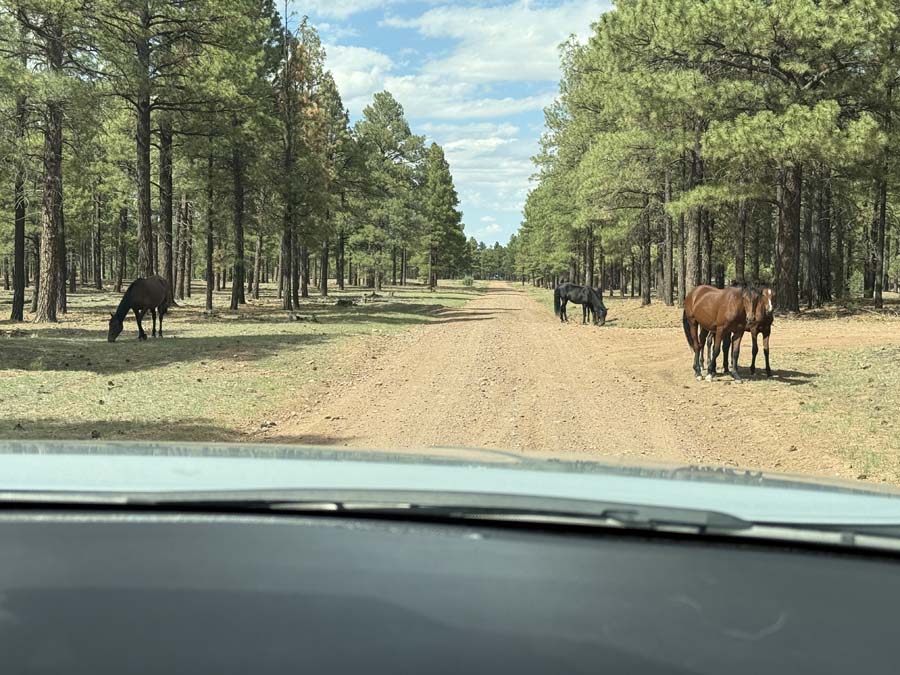
After a lovely ride, we loaded our horses and headed out of the forest. Unfortunately, we had to wait for more horses to clear the road before we were allowed to leave!
Did you enjoy this peek into my life with horses? If you love hearing about my equine adventures, from the Sonoran Desert to unexpected visitors, you can read more stories about my amazing four-legged friends on my other blog posts!
To learn about our latest science-based children’s books and workbooks, to read our latest blog posts about reptiles, birds, cats, and gardening, in a variety of locations, and about how the books come to be, what inspires an author to write, and many more interesting aspects of the publishing business, fill in the box below and we will add you to our email list.
Thank you!
